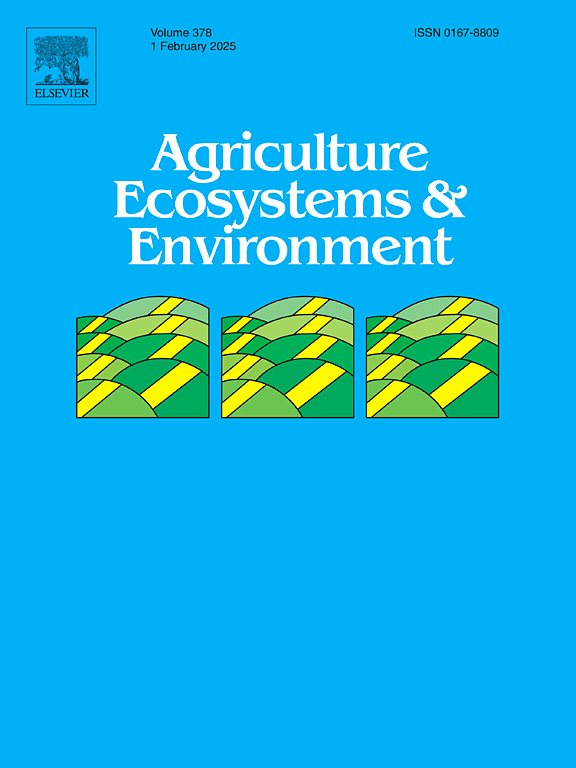Weed suppression and maize yield influenced by cover crop mixture diversity and tillage
IF 6.4
1区 农林科学
Q1 AGRICULTURE, MULTIDISCIPLINARY
引用次数: 0
Abstract
The integration of cover crops into cropping systems has demonstrated significant potential for enhancing weed suppression, improving soil health, and reducing dependence on chemical herbicides. A three-year field study conducted in Slovenia between 2020 and 2023 aimed to quantify the seasonal competitive relationships between cover crop and weeds while also evaluating potential yield benefits for the subsequent maize crop. A randomized complete block design accounted for variations in soil tillage (conventional and conservation) and cover crop type (single species: oilseed radish and berseem clover; a simple five-species cover crop mixture; and a functionally diverse seven-species cover crop mixture). Oilseed radish imposed the highest level of competition against weeds within the first four weeks post-sowing. The highest levels of weed suppression across years and tillage practices were observed with oilseed radish and the simple cover crop mixture (81–85 %). The functionally more diverse cover crop mixture was not more productive or weed suppressive than other cover crops neither did improve the level of weed control. The weed suppression level not closely linked to cover crop biomass production, suggests that rapid early growth may be more relevant functional trait for cover crop weed suppression capabilities. Maize yields were insignificantly improved with berseem clover and the most productive simple cover crop mixture by 0.7 t ha −1. The present study confirms the importance of cover crops as a key non-chemical weed management strategy for diversification. However, it also indicates the need for developing trait-based cover crop mixtures to further enhance cover crop-weed competition and main crop yield outcomes under specific resource availability, management practices, and desired ecosystem services.
覆盖作物多样性和耕作方式对杂草抑制和玉米产量的影响
将覆盖作物整合到种植系统中已显示出加强杂草抑制、改善土壤健康和减少对化学除草剂依赖的巨大潜力。2020年至2023年期间在斯洛文尼亚进行的一项为期三年的实地研究旨在量化覆盖作物和杂草之间的季节性竞争关系,同时评估后续玉米作物的潜在产量效益。随机完全区组设计考虑了土壤耕作方式(常规耕作和保护性耕作)和覆盖作物类型(单一物种:油籽萝卜和苜蓿;一种简单的五种覆盖作物混合物;以及一种功能多样化的七种覆盖作物混合物)。油籽萝卜在播种后的头四周内对杂草的竞争程度最高。油籽萝卜与简单覆盖作物混作对杂草的抑制在不同年限和不同耕作方式下均达到最高水平(81% ~ 85% %)。功能更多样化的复盖作物并不比其他复盖作物更多产或抑制杂草,也没有提高杂草控制水平。杂草抑制水平与覆盖作物生物量产量关系不密切,表明快速早期生长可能是覆盖作物杂草抑制能力更相关的功能性状。三叶草和最高产的简单覆盖作物混合物对玉米产量的提高不显著,提高幅度为0.7 t ha - 1。本研究证实了覆盖作物作为一种关键的非化学杂草多样化管理策略的重要性。然而,这也表明需要开发基于性状的覆盖作物组合,以进一步增强覆盖作物与杂草的竞争,并在特定资源可用性、管理实践和期望的生态系统服务下提高主要作物的产量。
本文章由计算机程序翻译,如有差异,请以英文原文为准。
求助全文
约1分钟内获得全文
求助全文
来源期刊

Agriculture, Ecosystems & Environment
环境科学-环境科学
CiteScore
11.70
自引率
9.10%
发文量
392
审稿时长
26 days
期刊介绍:
Agriculture, Ecosystems and Environment publishes scientific articles dealing with the interface between agroecosystems and the natural environment, specifically how agriculture influences the environment and how changes in that environment impact agroecosystems. Preference is given to papers from experimental and observational research at the field, system or landscape level, from studies that enhance our understanding of processes using data-based biophysical modelling, and papers that bridge scientific disciplines and integrate knowledge. All papers should be placed in an international or wide comparative context.
 求助内容:
求助内容: 应助结果提醒方式:
应助结果提醒方式:


